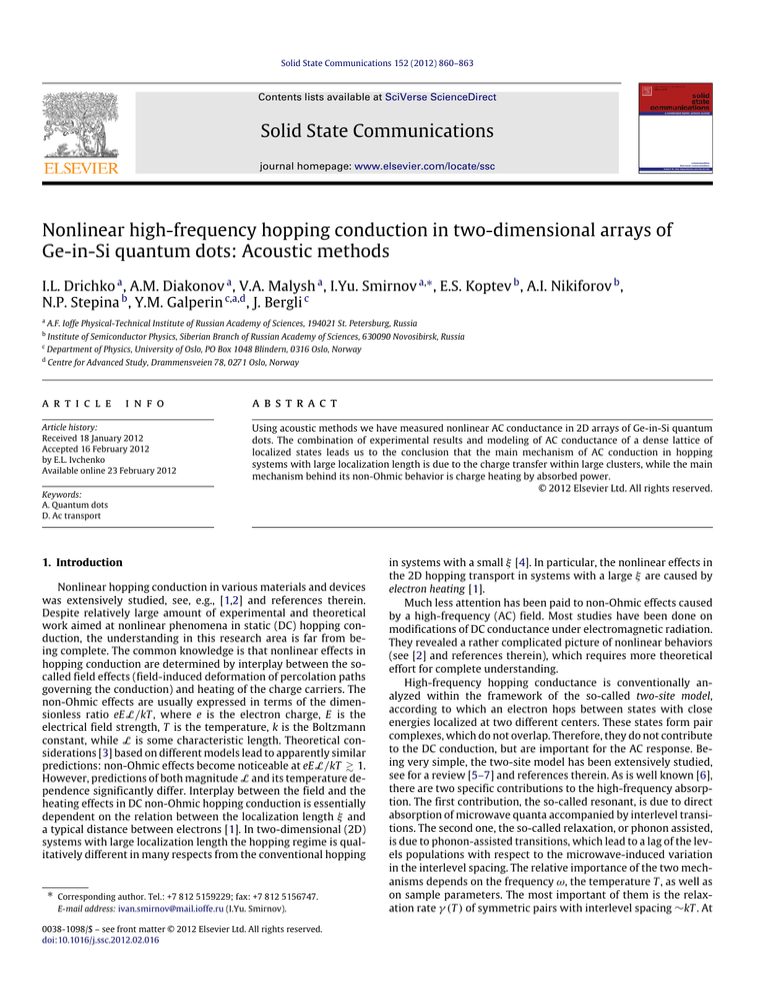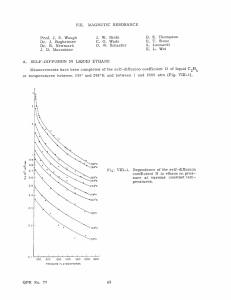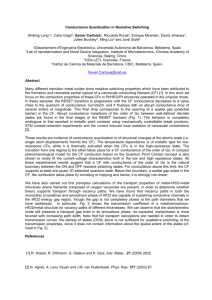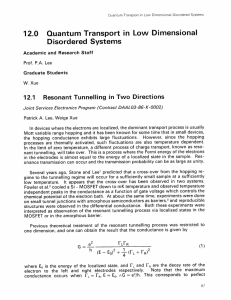
Solid State Communications 152 (2012) 860–863
Contents lists available at SciVerse ScienceDirect
Solid State Communications
journal homepage: www.elsevier.com/locate/ssc
Nonlinear high-frequency hopping conduction in two-dimensional arrays of
Ge-in-Si quantum dots: Acoustic methods
I.L. Drichko a , A.M. Diakonov a , V.A. Malysh a , I.Yu. Smirnov a,∗ , E.S. Koptev b , A.I. Nikiforov b ,
N.P. Stepina b , Y.M. Galperin c,a,d , J. Bergli c
a
A.F. Ioffe Physical-Technical Institute of Russian Academy of Sciences, 194021 St. Petersburg, Russia
b
Institute of Semiconductor Physics, Siberian Branch of Russian Academy of Sciences, 630090 Novosibirsk, Russia
c
Department of Physics, University of Oslo, PO Box 1048 Blindern, 0316 Oslo, Norway
d
Centre for Advanced Study, Drammensveien 78, 0271 Oslo, Norway
article
info
Article history:
Received 18 January 2012
Accepted 16 February 2012
by E.L. Ivchenko
Available online 23 February 2012
Keywords:
A. Quantum dots
D. Ac transport
abstract
Using acoustic methods we have measured nonlinear AC conductance in 2D arrays of Ge-in-Si quantum
dots. The combination of experimental results and modeling of AC conductance of a dense lattice of
localized states leads us to the conclusion that the main mechanism of AC conduction in hopping
systems with large localization length is due to the charge transfer within large clusters, while the main
mechanism behind its non-Ohmic behavior is charge heating by absorbed power.
© 2012 Elsevier Ltd. All rights reserved.
1. Introduction
Nonlinear hopping conduction in various materials and devices
was extensively studied, see, e.g., [1,2] and references therein.
Despite relatively large amount of experimental and theoretical
work aimed at nonlinear phenomena in static (DC) hopping conduction, the understanding in this research area is far from being complete. The common knowledge is that nonlinear effects in
hopping conduction are determined by interplay between the socalled field effects (field-induced deformation of percolation paths
governing the conduction) and heating of the charge carriers. The
non-Ohmic effects are usually expressed in terms of the dimensionless ratio eE L/kT , where e is the electron charge, E is the
electrical field strength, T is the temperature, k is the Boltzmann
constant, while L is some characteristic length. Theoretical considerations [3] based on different models lead to apparently similar
predictions: non-Ohmic effects become noticeable at eE L/kT & 1.
However, predictions of both magnitude L and its temperature dependence significantly differ. Interplay between the field and the
heating effects in DC non-Ohmic hopping conduction is essentially
dependent on the relation between the localization length ξ and
a typical distance between electrons [1]. In two-dimensional (2D)
systems with large localization length the hopping regime is qualitatively different in many respects from the conventional hopping
∗
Corresponding author. Tel.: +7 812 5159229; fax: +7 812 5156747.
E-mail address: ivan.smirnov@mail.ioffe.ru (I.Yu. Smirnov).
0038-1098/$ – see front matter © 2012 Elsevier Ltd. All rights reserved.
doi:10.1016/j.ssc.2012.02.016
in systems with a small ξ [4]. In particular, the nonlinear effects in
the 2D hopping transport in systems with a large ξ are caused by
electron heating [1].
Much less attention has been paid to non-Ohmic effects caused
by a high-frequency (AC) field. Most studies have been done on
modifications of DC conductance under electromagnetic radiation.
They revealed a rather complicated picture of nonlinear behaviors
(see [2] and references therein), which requires more theoretical
effort for complete understanding.
High-frequency hopping conductance is conventionally analyzed within the framework of the so-called two-site model,
according to which an electron hops between states with close
energies localized at two different centers. These states form pair
complexes, which do not overlap. Therefore, they do not contribute
to the DC conduction, but are important for the AC response. Being very simple, the two-site model has been extensively studied,
see for a review [5–7] and references therein. As is well known [6],
there are two specific contributions to the high-frequency absorption. The first contribution, the so-called resonant, is due to direct
absorption of microwave quanta accompanied by interlevel transitions. The second one, the so-called relaxation, or phonon assisted,
is due to phonon-assisted transitions, which lead to a lag of the levels populations with respect to the microwave-induced variation
in the interlevel spacing. The relative importance of the two mechanisms depends on the frequency ω, the temperature T , as well as
on sample parameters. The most important of them is the relaxation rate γ (T ) of symmetric pairs with interlevel spacing ∼kT . At
I.L. Drichko et al. / Solid State Communications 152 (2012) 860–863
Fig. 1. Sketch of the sample (left) and experimental setup (right).
√
γ kT /h̄ the relaxation contribution to the real part of AC conductivity σ1 (ω) dominates. In this case the imaginary component
of AC conductivity σ2 & σ1 , and σ1 (ω) ∝ ω with logarithmic accuω.
861
Fig. 2. Left—Magnetic field dependence of 1Γ at frequency 143 MHz for different
temperatures shown at the curves. Right—The same dependences replotted as
functions of B−2 . Sample 1.
racy. According to the two-site model, the non-Ohmic conductance
decreases with the field amplitude [7,8].
In this work we study nonlinear AC conductance in the samples
containing dense arrays of Ge-in-Si quantum dots (QDs) using
probe-free acoustic method [9]. We will show that AC conduction
of dense QD arrays is similar to that in hopping semiconductors
with large localization length.
2. Experiment
Samples. We study B-doped arrays of Ge-in-Si QDs with densities n = (3–4) × 1011 cm−2 and filling factors ν ≈ 2.5–2.85 [10].
The samples were grown by Stranski–Krastanov molecular beam
epitaxy on a (001) Si substrate. The QD array layer was located at
40 nm from the sample surface (see the sketch in the left panel of
Fig. 1). QDs are shaped as pyramids with a height of 10–15 Å and
a square base with sides of 100–150 Å. The samples were δ -doped
with B, the density in the doped layer being ∼1012 cm−2 . In these
systems two lowest states in Ge QDs are occupied by holes, and
the third level is partly occupied. The 4th state is split from the 3rd
one by 18–23 meV [11]. Therefore, the 4th level is expected to be
empty in the temperature domain of interest.
We studied AC conductance of two samples, which were
annealed and were close in conductance. The aim of annealing was
increasing of the sample conductance; during the annealing the
dots spread and the distance between them decreases from initial
∼15 nm to almost overlapping. The samples studied in [12] had
larger conductance and therefore AC hopping conductance was not
observed there.
Procedure. We used the probeless acoustic method to determine
the complex ac conductance, σ ≡ σ1 − iσ2 , from attenuation, Γ ,
and velocity, V , of a surface acoustic wave (SAW) induced on the
surface of a LiNbO3 piezoelectric crystal by interdigital transducers,
see right panel of Fig. 1. The sample is pressed to the crystal surface
by a spring. A SAW-induced AC electric field penetrates into the
sample and interacts with charge carriers (holes). As a result, both
Γ and V acquire additional contributions, which can be related to
complex σ [9]. We single out these contributions by measuring the
changes induced by external transverse magnetic field, 1Γ (B) ≡
Γ (0)− Γ (B), and similarly 1V (B). For these particular samples 1V
is not measurable thus indicating that σ2 ≪ σ1 . Therefore, further
we will discuss only 1Γ and σ1 . Since the hole absorption vanishes
in very high magnetic fields we extrapolate experimentally found
1Γ (B) to to B → ∞ and in this way find Γ (0) ≡ Γ versus
temperature and SAW frequency at frequencies 30–414 MHz in the
temperature domain 1.8–13 K.
Linear regime. Shown in the left panel of Fig. 2 are magnetic field
dependences of 1Γ at f = 143 MHz and B ≤ 8 T for different
temperatures. These dependences are replotted in the right panel
as functions of B−2 , which can be represented as straight lines. The
Fig. 3. Left—Temperature dependences of σ1 (ω) in the sample 1 for f = 30.1 and
307 MHz. a = 5 × 10−5 cm. Right—Frequency dependence of σ1 in the sample 2 at
T = 4.2 K. a = 4 × 10−5 cm. The lines are visual guides.
attenuation coefficient at B = 0, Γ , is determined by crossing of
these lines with the axis B−2 = 0. For the situation relevant to
the present experiment the general expression [9] relating Γ with
σ1 (ω) can be simplified as
Γ (dB/cm) = 4.34K 2 qA(q)4π t (q)σ1 (ω)/εs V .
(1)
Here q ≡ ω/V is the SAW wave vector, K is the piezoelectric
coupling constant in the LiNbO3 , A(q) and t (q) are geometric
factors given in [9], which depend on the dielectric constants of
the sample (εs ), vacuum (ε0 ) and substrate (ε1 ), as well as on the
depth of the QD layer and the clearance a between the sample and
substrate. The above expression is valid provided σ2 ≪ σ1 ≪
εs V /4π t (q) that is the case in the present situation.
Shown in the left panel of Fig. 3 are temperature dependences of
σ1 for sample 1 at frequencies 30.1 and 307 MHz found from Eq. (1).
The clearance a was determined from Newton’s rings. Frequency
dependence of Γ for sample 2 at T = 4.2 K is shown in the right
panel.
Nonlinear regime. Shown in the left panel of Fig. 4 are magnetic field
dependences of 1Γ at frequency f = 253 MHz at T = 1.8 K for
different input SAW intensities. Similarly to the linear regime, the
values Γ (0), and σ1 were determined by extrapolation to B → ∞.
The intensities W were determined as follows. Firstly, the signal
having passed through the system was compared with the input
signal from the generator. This comparison allowed determining
the transformation losses in both transducers plus the losses in
input and output transmission lines (which are considered to be
equal). The intensity was changed by synchronous changing of
the calibrated attenuators installed after the generator and after
the output transducer keeping the summary attenuation (in dB)
constant. Knowing the transformation losses in one transducer and
in the input line we find the acoustic intensity after the input
transducer. Similar measurements were done for f = 30, 143 and
253 MHz.
Since for each frequency the inequality Γ L ≪ 1 (where Γ is the
attenuation coefficient in cm−1 while L = 4 − 5 mm is the sample
length) is met, one can neglect the difference between the input
and output intensities while calculating the typical amplitude E of
862
I.L. Drichko et al. / Solid State Communications 152 (2012) 860–863
Fig. 4. Left—Magnetic field dependences of 1Γ at frequency f = 253 MHz at
T = 1.8 K for different input SAW intensities. Right—The dependence σ1 (E ) for
T = 1.8 K with the line acting as a visual guide. Sample 1.
Fig. 5. Dependence of 1σ /σ1 (0) on the dimensionless parameter (eE L/kT )2 . Here
1σ (E ) ≡ σ1 (E ) − σ1 (0), while L is a characteristic length chosen as 7.5 × 10−6 cm.
f = 142 MHz, T = 3, 3.3, 4.2 and 7 K. Sample 2. The line is a visual guide.
the SAW-induced electrical field. It is evaluated from the energy
conservation law 2Γ W = σ1 (E )E 2 /2. This procedure is valid since
due to the inequality Γ L ≪ 1 higher harmonics of the signal are
weak. The obtained in this way dependence σ1 (E ) for sample 1, at
T = 1.7 K and different frequencies is shown on the right panel of
Fig. 4. One can observe very weak frequency dependence.
The regime of weak non-Ohmic behavior (E ≤ 100 V/cm)
was investigated in more detail for sample 2 at f = 142 MHz and
different temperatures, T = 3, 3.3, 4.2 and 7 K. The dependences
1σ /σ1 (0) ≡ [σ1 (E )/σ1 (0) − 1] on dimensionless parameter
(eE L/kT )2 are shown in Fig. 5. The characteristic length L is
chosen as 7.5 × 10−6 cm in order to have 1σ /σ1 (0) = 1 at
(eE L/kT )2 = 1. One observes an approximate data collapse.
3. Simulations
Since we are not aware of any analytical theory for AC hopping
conduction in dense QD arrays we have performed numerical
simulations for a model system consisting of a L × L square lattice
of randomly occupied localized states [13]. We put L = 100
having in mind that for this size we know that finite size effects
are not appreciable in DC conductance [14]. Each of the states can
be either empty or occupied (double occupancy is not allowed).
The simulations were performed for the filling factor of 1/2, so that
the number of electrons is half the number of sites. Disorder is
introduced by assigning a random energy in the range [−U , U ] to
each site (in our numerics we have used U = e2 /d where d is the
lattice constant). Each site is also given a compensating charge ν e
so that the overall system is charge neutral. The charges interact
via the Coulomb interaction. In the following the unit of energy is
chosen as the Coulomb energy of unit charges on nearest neighbor
sites, e2 /d. The unit of temperature is then e2 /dk.
To simulate the time evolution we used the dynamic Monte
Carlo method introduced in Ref. [15] for simulating DC transport.
The only difference is that we apply an AC electric field E =
E0 cos ωt and that, following Ref. [16], we use for the transition rate
of an electron from site i to site j the formula
γij = τ0 −1 e−2rij /ξ min(e−εij /kT , 1)
(2)
Fig. 6. AC conductivity as function of frequency (left panel) and of electrical field
(right panel) for T = 0.03.
where εij is the energy of the phonon and rij is the distance between
the sites. τ0 contains material dependent and energy dependent
factors, which we approximate by their average value; we consider
it as constant and its value, of the order of 10−12 s, is chosen as our
unit of time. Consequently, ω is measured in units of τ0−1 while
the electric field is measured in units of e/d2 . The conductance
(in Siemens) is expressed in units of 4π ϵ0 d/τ0 . Note that our
model is oversimplified comparing to realistic dense QD arrays. In
particular, the model assumes a hydrogen-like wave function with
localization length ξ and independent of the phonon wave vector
electron–phonon coupling, we ignore dielectric susceptibility of
the host, etc. Therefore, we hope to reproduce the behavior of
AC conductance only qualitatively. However, we believe that the
model reproduces main physics of the dense arrays—interplay
between Coulomb correlations and disorder as well as relatively
large ratio between ξ and a distance between the dots. To decrease
the number of independent parameters we put ξ = d.
Shown in Fig. 6 (left panel) is the conductance versus frequency
for T = 0.03 (corresponding to the Efros–Shklovskii regime) and
E0 = 0.003 which we know is close to the upper limit of the
Ohmic regime for DC transport [14]. Dependences of σ on the field
amplitude for different frequencies are shown in the right panel.
As it is seen, the conductance grows with frequency, as well as
with electric field that qualitatively agrees with the experimental
results shown in Figs. 3 and 4 (right panels).
We can present the results in a different form: assuming that
the non-Ohmic behavior is due to heating of the charge carriers we
would expect that the conductance at a large field will be the same
as the Ohmic conductance at a higher temperature corresponding
to the electron temperature. This is known to be approximately
true for DC conductivity [17,14]. Thus, we expect a relation of the
form
σ (Teff , E , ω) = σ (T , 0, ω)
(3)
where Teff (E ) is the effective electron temperature while σ (T , 0, ω)
is the Ohmic AC conductance. In the simulations we can check the
accuracy of this relation by independent calculation of σ (ω) and
Teff . The latter was found from direct fitting of the Fermi function
to the actual distribution function of occupied sites obtained by
averaging over 20 states. We also found the Ohmic conductivity
as function of temperature for different frequencies. If relation (3)
holds we should find at a given frequency the following: as the
electric field is increased, both the effective temperature and the
conductivity increase in such a way that the points σ (T , E , ω) follow
√the same curve as the Ohmic conductivity. We plot σ versus
1/ Teff for different frequencies in Fig. 7 (left panel). As we can see,
relation (3) is approximately satisfied. Therefore, we have used it
as a definition of the electron temperature allowing us to extract
it from experimental data on σ (T , E , ω) and σ (T , 0, ω). Shown
in the right panel of Fig. 7 is the relationship between so-defined
Teff and the absorbed power, σ (T , E , ω)E 2 , for the lattice temperature of 1.8 K. Here we used averaged data for different frequencies since the frequency dependence is rather weak. The results are
I.L. Drichko et al. / Solid State Communications 152 (2012) 860–863
863
Acknowledgment
This work was supported by grant of RFBR 11-02-00223, grant
of the Presidium of the Russian Academy of Science, the Program
‘‘Spintronika’’ of the Branch of Physical Sciences of RAS.
References
√
Fig. 7. Left—Conductance as a function of 1/ Teff for various frequencies. The large
symbols connected by lines show the ohmic conductivity (for which Teff = T ).
The small symbols show the non-Ohmic conductivity at a finite field. Each symbol
corresponds to a different frequency. Right—Relationship between σ (T , E )E 2 and
6
Teff
− T 6 for sample 1 at T = 1.8 K.
6
compatible with the dependence Teff
− T 6 ∝ σ (T , E )E 2 . Interestingly, a similar dependence was reported for amorphous InOx films,
which are on the dielectric side of a insulator-to-superconductor
transition [18]. Though such a dependence was predicted for a
metallic state [19], we are not aware of any analytical theory explaining such a dependence in the insulating phase.
4. Conclusion
Using acoustic methods we have measured real part of
nonlinear AC conductance in insulating 2D arrays of Ge-in-Si QDs.
The observed features – inequality σ1 & σ2 , increasing of σ1 with
the field amplitude, its relatively weak
√ frequency dependence,
large energy exchange length L & 1/ n – essentially contradict
the predictions of the two-site model discussed in Section 1.
The dissipation is rather due to electron transitions in multi-site
clusters. This is not surprising because the two-site model requires
the close pairs to be isolated that can be met only in dilute systems.
The observed non-Ohmic behavior is attributed to heating of the
charge carriers by AC electrical field, as in the DC case [1]. We have
also performed simulations of AC conductance in a dense 2D lattice
of localized states taking into account both distribution of their
energies and Coulomb correlations. The results qualitatively agree
with the experiment confirming the above conclusion.
[1] M.E. Gershenson, et al., Phys. Rev. Lett. 85 (2000) 1718.
[2] Z. Ovadyahu, Phys. Rev. B 84 (2011) 165209.
[3] R.M. Hill, Phil. Mag. 24 (1971) 1307;
B.I. Shklovskii, Fiz. Tekh. Poluprovodn. 6 (1972) 2335; Sov. Phys. Semicond.
6 (1973) 1964;
N. Apsley, H.P. Hughes, Phil. Mag. 31 (1975) 1327;
M. Pollak, I. Riess, J. Phys. C 9 (1976) 2339;
B.I. Shklovskii, Fiz. Tekh. Poluprovodn. 10 (1976) 1440; Sov. Phys. Semicond.
10 (1976) 855;
B.I. Shklovskii, Fiz. Tekh. Poluprovodn. 13 (1979) 93;
I.P. Zvyagin, Phys. Status Solidi B 88 (1978) 149.
[4] B.I. Shklovskii, A.L. Efros, Electron Properties of Dopes Semiconductors,
Springer-Verlag, Berlin, 1984.
[5] A.L. Efros, Zh. Eksp. Teor. Fiz. 89 (1985) 1834;
Sov. Phys. JETP 62 (1985)
1057.
[6] A.L. Efros, B.I. Shklovskii, in: A.L. Efros, M. Pollak (Eds.), Electron–Electron
Interactions in Disordered Systems, North-Holland, Amsterdam, 1985, p. 409.
[7] Y.M. Galperin, V.L. Gurevich, D.A. Parshin, in: B. Shklovskii, M. Pollak (Eds.),
Hopping Transport in Solids, Elsevier, NY, 1991.
[8] Y.M. Galperin, M. Kirkengen, Phys. Rev. B 56 (1997) 13615;
Y.M. Galperin, M. Kirkengen, Phys. Rev. B 62 (2000) 16624.
[9] I.L. Drichko, A.M. Diakonov, I. Yu.Smirnov, Y.M. Galperin, A.I. Toropov, Phys.
Rev. B 62 (2000) 7470.
[10] N.P. Stepina, E.S. Koptev, A.V. Dvurechenskii, A.I. Nikiforov, Phys. Rev. B 80
(2010) 23.
[11] A.I. Yakimov, Electronic phenomena in Ge-in-Si quantum dot arrays, Dr. Sci.
Thesis, Novosibirsk 2001 (in Russian).
[12] I.L. Drichko, A.M. Dyakonov, I.Yu. Smirnov, A.V. Suslov, Y.M. Galperin,
A.I. Yakimov, A.I. Nikiforov, Zh. Eksp. Teor. Fiz. 128 (2005) 1279; Sov. Phys.
JETP 101 (2005) 1122.
[13] J.H. Davies, P.A. Lee, T.M. Rice, Phys. Rev. Lett. 49 (1982) 758.
[14] A. Voje, MD. Thesis, UiO, 2009. http://urn.nb.no/URN:NBN:no-26080.
[15] D.N. Tsigankov, A.L. Efros, Phys. Rev. Lett. 88 (2002) 176602.
[16] K. Tenelsen, M. Schreiber, Phys. Rev. B 52 (1995) 13287;
A. Díaz-Sánchez, et al., Phys. Rev. B 59 (1999) 910.
[17] M. Caravaca, A.M. Somoza, M. Ortuño, Phys. Rev. B 82 (2010) 134204.
[18] M. Ovadia, B. Sacépé, D. Shahar, Phys. Rev. Lett. 102 (2009) 176802.
[19] A. Schmid, Z. Phys. 271 (1974) 251;
M. Reizer, A. Sergeyev, JETP 63 (1986) 616.







